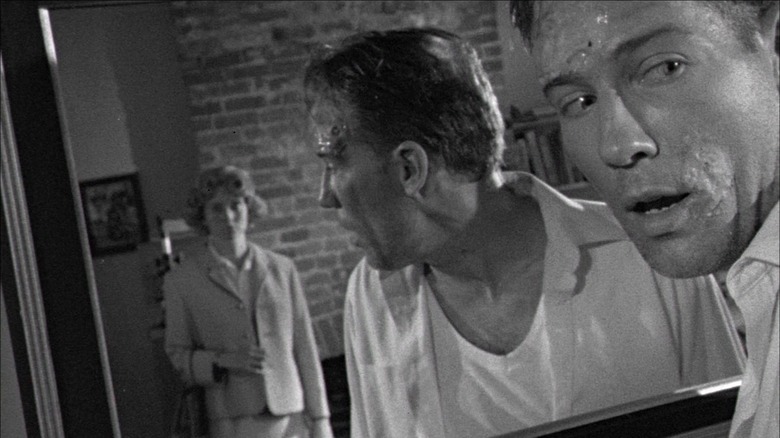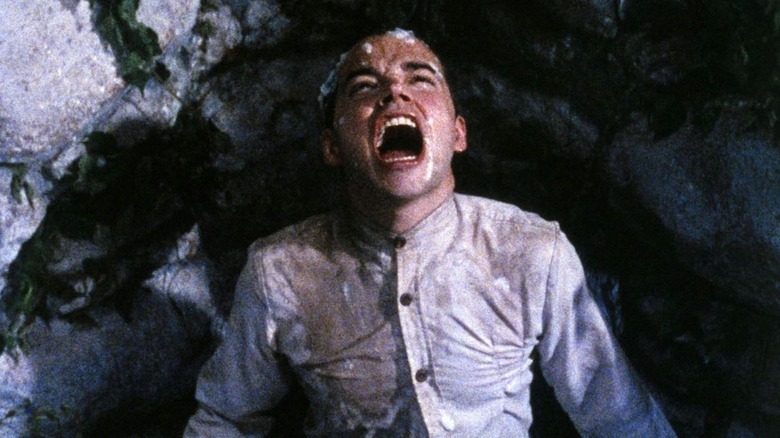The Todd Haynes Poison Controversy Explained: An Indie Classic Goes To The Culture Wars
If Reverend Donald Wildmon of the far-right American Family Association was to be believed in 1991, the United States government had, via the National Endowment for the Arts, financed gay porn. The movie in question was Todd Haynes' "Poison," a triptych of short stories riffing on the work of homosexual writer Jean Genet, and, you probably won't be surprised to learn, was as far from a skin flick as "A Man for All Seasons." The truth, however, didn't matter. That Haynes' was an out gay flmmaker who'd received taxpayer money to make a movie examining the "panicky fright" of a society that could not, for the most part, accept the strangeness (i.e. non-straightness) of their fellow human beings infuriated religious bigots like Wildmon. They could sense the cultural tide was turning against them, so they rallied their hateful base to protest a handful of drop-in-the-bucket government grants.
"Poison" was just the latest flare-up in the conservative war against the NEA. Throughout the 1980s, Republican politicians like Jesse Helms, Dick Armey, and Newt Gingrich claimed they were targeting wasteful spending as well as allegedly prurient art, but their targets were almost always minorities. Their crusade kicked off in 1989 when they learned of Andres Serrano's "Piss Christ," a photograph of a crucifix submerged in a vial of the artist's urine. Prior to this, most Americans were probably unaware of the NEA's existence. Now, a vocal segment of the public wanted to abolish it for providing financial assistance to a blasphemer.
Then came Robert Mapplethorpe.
The NEA Wars
When it was revealed Washington D.C.'s Corcoran Museum of Art was to receive NEA backing for an exhibition of photographs by Mapplethorpe, the right went absolutely berserk. The artist, who'd died of AIDS earlier in '89, had taken sexually explicit pictures of sadomasochistic acts. There were also two shots of children where their genitals were exposed, but the primary objection of the right had everything to do with the public funding of gay art.
When the Corcoran Museum buckled under political pressure, the Cincinnati Contemporary Arts Center stepped up and hosted the exhibit. The so-called Queen City of Ohio resides in a red corner of the state, and its most bigoted denizens turned out in droves to protest the museum's presentation. This led to a potentially dangerous obscenity trial — which should've never been heard in the first place — that thankfully shook out in the museum's favor.
Despite these high-profile, would-be scandals, the NEA's budget, though hardly significant in the grand scheme of government spending, continued to rise. The religious right needed another boogeyman, and they found it when Haynes' "Poison" premiered at the 1991 Sundance Film Festival (where it won the Grand Jury Prize).
Homophobia rears its ugly head
Haynes was no stranger to controversy. His brilliant "Superstar: The Karen Carpenter Story" told the musician's tragic story via Barbie dolls, which might sound like a goof in theory, but is absolutely shattering in its execution. Alas, its unlicensed use of Carpenters songs and unflattering depiction of Karen's brother Richard spurred the musician to file a successful copyright infringement lawsuit against Haynes, which turned it into one of the most sought-after cult movies in existence.
"Poison" was Haynes' first feature-length film, and while it's formally audacious, the content barely raised an eyebrow. But it was a gay movie based on the work of a gay writer that focused to an extent on gay people, which made it a sinful work in the eyes of a scold like Wildmon. Once he learned "Poison" had been co-financed by the NEA, he declared Haynes' film featured "explicit porno scenes of homosexuals involved in anal sex." This was a lie, but it was rare at the time to run across a piece of legitimate reportage willing to debunk Wildmon's claims. The media's wrongheadedly even-handed coverage felt especially egregious given the awful toll the AIDS epidemic had taken on the gay community. This was an important film in the burgeoning New Queer Cinema movement, and it was getting shellacked by a pack of well-funded homophobes.
The NEA mounts a tepid defense
It fell to newly appointed NEA chairman John E. Frohnmayer to steer the organization out of choppy waters, and he clumsily played the middle. He went to bat for Haynes' artistic vision by rejecting charges of prurience (insisting that "Poison" was "the work of a serious artist dealing with a serious issue in our society"), but he needlessly kowtowed to bad-faith Republican criticism by instituting a codicil in the NEA application that forced the artist to promise the finished work would not be "obscene" — thus leaving creators one bum ruling away from being in violation of their agreement. Fortunately, no one ever ran afoul of this unprovable condition.
Despite Helms condemning the film on the floor of the U.S. Senate, "Poison" received a limited release from Zeitgeist Films in the spring of 1991, at which point the furor over its non-existent pornographic content died down. You could argue that this was yet another defeat for the religious right in the culture wars, but the fact that their baseless charges were ever taken seriously was a victory for the movement's unabashed mendacity.
The culture wars wage on
The NEA budget got slashed when Gingrich's GOP seized control of Congress during the Clinton era, but funding has increased over the last two decades. Adjusted for inflation, the endowment is nowhere near as substantial as it used to be, but given the numerous, media-amplified assaults on its efforts, it's something of a miracle that it still exists at all.
As for Haynes, he followed up "Poison" with the paralyzing environmental horror of "Safe," which is arguably the best film of the 1990s. The formal audacity of his early work matured into mastery; movies like "Far from Heaven," "I'm Not There," and "Carol" are advanced genre/cultural commentaries that grow more fascinating the more you deconstruct them. They're about how we live, how we interpret art and why that art exists. As a straight man, this particular language was completely foreign to me until I engaged with the work of Gus Van Sant, Tony Kushner, and Haynes. I'm indebted to these artists, and to the people who stood up against hateful bullies like Wildmon, Helms, and Gingrich. Culture was on the ropes for a moment there, and some incredibly brave folks helped art fight its way out of the corner.




